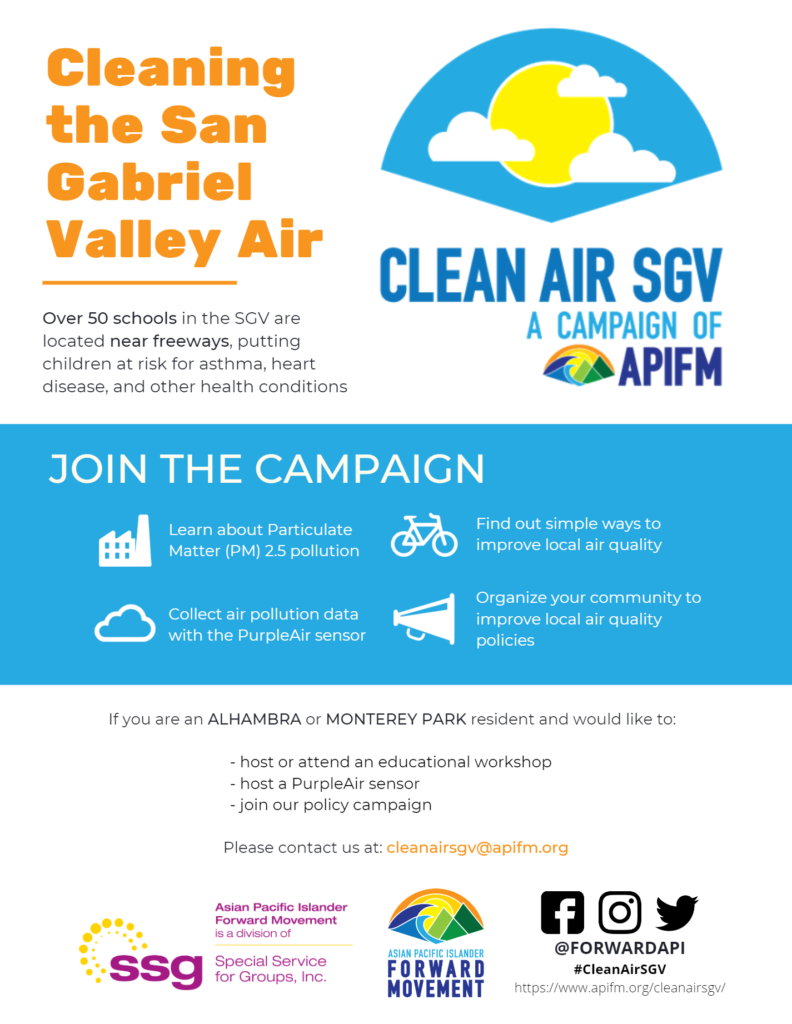Why CleanAirSGV?
THE PROBLEM
There are over 50 schools in the San Gabriel Valley located closer than the recommended 500 feet to a major roadway or freeway. Research shows that proximity to freeways is closely linked to health issues like asthma, heart disease, cancer, obesity, and diabetes. Given that the San Gabriel Valley is surrounded by the 710, 10,110, 210, 605 and 60 freeways, the health of thousands of San Gabriel Valley youth are put at-risk each day. According to the South Coast Air Quality Management District (SCAQMD), over 60% of the nation’s containerized goods enter through the ports of Los Angeles and Long Beach where they are offloaded and shipped across the country by either truck, train, or plane. Much of this cargo passes through the San Gabriel Valley region as it makes it way to other places across the country.
HISTORY
In 2012, APIFM began to spread the roots that created the Clean Air SGV program. While working with high school students at Mark Keppel High School (MKHS), the students expressed concern about the air pollution. MKHS was located less than 500 feet from the I-10 freeway, one of the most congested freeways in the Los Angeles region.
To address this issue, APIFM took a multi-pronged approach. We worked on educating the community on the issues of air quality in our region. We provided air quality monitors to allow residents to be aware of the levels of air pollutants. And, we formed a stakeholder group made of elected officials, teachers, students, and community leaders to discuss policy solutions that would improve air quality.
COMMUNITY HEALTH PROFILES
- Alhambra, CA ( English | 中文 | Español | Tiếng Việt )
- Monterey Park, CA ( English | 中文 | Español | Tiếng Việt )
- Effects of Air Pollution on COVID-19 ( English | 简体中文 | 繁體中文 | Español | Tiếng Việt )

DOWNLOAD THE FLYER:
In 2015, APIFM partnered with USC, Cal State Fullerton, and Pitzer College to create low-cost air sensors alongside youth at San Gabriel Valley schools using 3D printers and Arduino coding. Utilizing STEM education, APIFM started collecting data with the help of students, teachers, and principals in order to better understand how the air quality near schools are impacted.
In 2017, APIFM received funding to purchase and install 50 Purple Air Sensors to more accurately measure air quality in the cities of Alhambra, Monterey Park, Pasadena, and San Gabriel. This year, APIFM will be installing 64 more Purple Air Sensors and convening workshops to help educate the community about air quality issues. We will also partner with Claremont McKenna College’s Roberts Environmental Center to conduct localized analysis of the data collected from all the Purple Air Sensors the organization has distributed in the communities of Alhambra and Monterey Park. Finally, we will work with local community residents and stakeholders in Alhambra and Monterey Park to develop and propose creative solutions to mitigate the impact of air pollution on these communities.
- Inform and raise awareness of air quality issues specific to San Gabriel Valley communities
- Provide communities with the tools necessary to measure air quality in their neighborhoods
- Engage local communities in conversation to develop tangible, actionable policy solutions that will improve air quality for all residents
- Attend an upcoming APIFM workshop, training, and/or stakeholder meeting. The calendar of events can be found [here].
- Host a purple air sensor at your residence, business, or local public space.
- Volunteer with APIFM to help conduct workshops and trainings.
- Volunteer with APIFM to meet with local elected officials about air quality issues.
- Host a gathering with your friends, church, organization, business or more so APIFM can reach more people about air quality matters in the San Gabriel Valley


